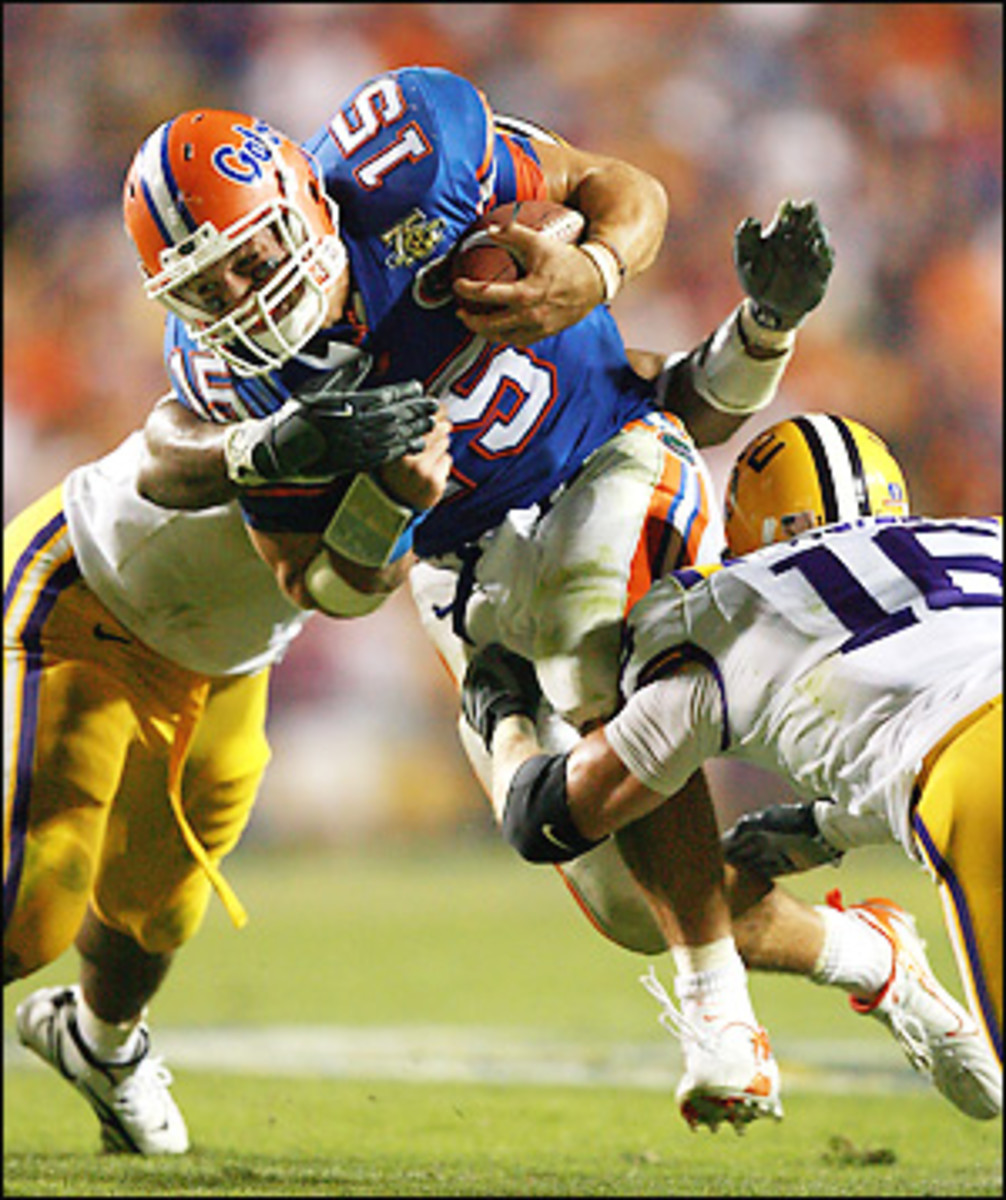
The Tebow effect
The YouTube clip's first title was "Jeff McVaney Highlights," which, while accurate, didn't exactly stir the blood. It changed after people started telling John McVaney that watching his son, a 6-foot-2, 218-pound quarterback, burst up the middle, drag tacklers and fling left-handed touchdowns reminded them of someone else.
So Jeff McVaney's older brother changed the title of the highlight clip. Want to find it? A quick Google search for "The Next Tim Tebow" produces this link as the top result. Now meet Jeff McVaney, who, until everyone began looking for a duplicate of Florida's Heisman-winning sophomore quarterback, projected to be a Division I-AA fullback or linebacker.
McVaney, a senior at Houston's Strake Jesuit, had been looking at Holy Cross and Penn. A few weeks ago, he started getting calls from Kansas and Oklahoma. Father John said LSU and Texas A&M have discussed walk-on spots. The big schools haven't offered scholarships yet, but McVaney might get an official visit or two. After that, who knows?
"We cheer for the Tebow kid," John McVaney said, "because his success is getting Jeff noticed."
It seems every college coach is hunting for a clone of Tebow, who accounted for 55 touchdowns this season and became the first sophomore to win the Heisman. Either they run the spread and want to run it better, or they want a dual-threat quarterback who can serve as a change of pace -- much like Tebow did for Florida starter Chris Leak during the Gators' 2006 national title run. At the very least, coaches want a scout-team quarterback who can simulate the spread offenses that are bound to pop up at opposing schools now that Florida, West Virginia, Oregon, Illinois and others have proven the spread can work in any conference.
Even if Tebow hadn't won the Heisman, coaches still would sacrifice appendages to sign Jeannette (Pa.) High dual-threat quarterback Terrelle Pryor. But would they go out of their way to call McVaney, who only played quarterback this season because his team's signal-caller transferred? Granted, he did throw for nearly 2,000 yards and ran for nearly 1,000, including 166 yards in a first-round playoff loss to Katy, the eventual Texas Class 5A Division II state champ. Still, would the coaches have noticed if not for Tebow?
Calling it "The Tebow Effect" is unfair to Texas's Vince Young, West Virginia's Pat White, Oregon's Dennis Dixon and the others who have helped elevate the spread to a scoreboard-rattling art form. But Tebow gets much of the credit, and players who compare favorably to him probably will get a second look instead of being sent to block with the fullbacks. Players already recruited as quarterbacks who just so happen to share traits with Tebow will get even more attention.
The aforementioned Google search for "The Next Tim Tebow" doesn't produce just one result. Right below McVaney's highlight film, you'll find this link.
But for the uniform colors and the size of the players, the scene looks like the start of a Florida or Oregon play. Five receivers spread wide. A quarterback -- not much smaller than his linemen -- is in the shotgun. The ball is snapped, and the quarterback bursts forward. He blasts through the line, past the linebackers. Only the free safety stands in his way. Boom! The free safety lands on his back, but his mangled body slows the quarterback enough to allow a pair of teammates to drag him down inches from the goal line.
You've just met Clark Evans, the junior quarterback at Los Alamitos (Calif.) High. Plenty of college coaches want to meet Evans, Los Alamitos coach John Barnes said. The 6-4, 220-pounder threw for 2,358 and 16 touchdowns and ran for 958 yards and 13 touchdowns in 10 games this past season. And when his team needed to ram the ball into the end zone, Barnes had Evans run an old-school single wing. Evans did it so well that Barnes would joke that Evans should have been a candidate for the 1954 Heisman. And when recruiters ask Barnes about Evans, Barnes brings up a familiar name.
"I tell coaches he's Tim Tebow," Barnes said.
Those similarities could make Evans one of the nation's most sought-after quarterbacks in the Class of 2009. Coaches from every conference want a Tebow-type, and the number of spread-worshippers grows by the month. New Auburn offensive coordinator Tony Franklin will install a version of the spread to better showcase Tigers quarterback Kodi Burns. Meanwhile, Rich Rodriguez will bring his version of the spread from West Virginia to Michigan. Even programs that haven't fully embraced the spread have incorporated elements of it. LSU, which claimed the national title Monday night, used backup quarterback Ryan Perrilloux all season as a run-throw threat.
Michigan's Rodriguez, one of the spread's founding fathers, said last week that competition for dual-threat quarterbacks on the recruiting trail has grown fierce and could only get worse.
"A lot of people are looking for those guys now, even some of the teams that don't traditionally run the spread," Rodriguez said. "They're telling those guys, 'We'll change the offense if you come here.' "
No one has offered to change their offense for Jeff McVaney, but football's latest fad has opened more eyes, and, he hopes, more doors. McVaney, a left-handed pitcher with a 91-mph fastball who hopes to play two sports in college, believes Tebow's success helped him get noticed.
"I started talking to more people," McVaney said. "Tebow is helping the guys that play like me."





